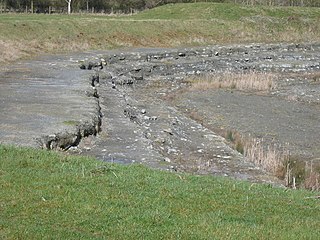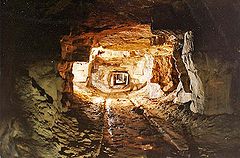The Taynton Limestone is a geological formation in Oxfordshire in the United Kingdom. It dates to the Middle Jurassic, mid-Bathonian stage. It predominantly consists of ooidal grainstone. The term "Stonesfield Slate" refers to slaty limestone horizons within the formation that during the 18th and 19th centuries were extensively quarried for use in roof tiling within the vicinity of Stonesfield, Oxfordshire. Previously these were thought to belong to the Sharp's Hill Formation, but boreholes and shaft sections suggest that at least three horizons within the Taynton Limestone were quarried for the slate. These horizons are well known for producing a diverse set of fossils including those of plants, insects as well as vertebrates, including some of the earliest known mammals, pterosaurs as well as those of first dinosaur ever described, Megalosaurus.

The Inferior Oolite is a sequence of Jurassic age sedimentary rocks in Europe. It was deposited during the Middle Jurassic. The Inferior Oolite Group as more recently defined is a Jurassic lithostratigraphic group in southern and eastern England. It has been variously known in the past as the Under Oolite, the Inferior Oolite, the Inferior Oolite Series and the Redbourne Group.
The Al-Khod Conglomerate is a Mesozoic geologic formation in Oman. Dinosaur remains belonging to ornithischians, theropods and sauropods are among the fossils that have been recovered from the formation, although none have yet been referred to a specific genus, which belong to one of very few records of dinosaur remains currently known from Oman.
The Ashizawa Formation is a Coniacian geologic formation in northeastern Honshu, Japan. Dinosaur remains are among the fossils that have been recovered from the formation, although none have yet been referred to a specific genus. A jawbone belonging to a therian mammal has also been discovered from this unit.

The Cornbrash Formation is a Middle Jurassic geological formation in England. It ranges in age from Bathonian to Callovian, the uppermost part of the Middle Jurassic. Dinosaur remains are among the fossils that have been recovered from the formation, although none have yet been referred to a specific genus. The name Cornbrash is an old English agricultural name applied in Wiltshire to a variety of loose rubble or brash which, in that part of the country, forms a good soil for growing corn. The name was adopted by William Smith for a thin band of shelly limestone which, in the south of England, breaks up in the manner indicated. Although only a thin group of rocks, it is remarkably persistent; it may be traced from Weymouth to the Yorkshire coast, but in north Lincolnshire it is very thin, and probably dies out in the neighborhood of the Humber. It appears again, however, as a thin bed in Gristhorpe Bay, Cayton Bay, Wheatcroft, Newton Dale and Langdale. In the inland exposures in Yorkshire it is difficult to follow on account of its thinness, and the fact that it passes up into dark shales in many places the so-called clays of the Cornbrash, with Avicula echinata. The Cornbrash is of little value for building or road-making, although it is used locally; in the south of England it is not oolitic, but in Yorkshire it is a rubbly, marly, frequently ironshot oolitic limestone. In Bedfordshire it has been termed the Bedford limestone.
The Donoho Creek Formation is a Mesozoic geologic formation in South Carolina. Dinosaur remains are among the fossils that have been recovered from the formation.
The In Beceten Formation, also Beceten or Ibecten is a Coniacian to Santonian geologic formation in the Iullemmeden Basin of Niger. It has yielded a diverse fauna and some angiosperms. Among others, it has yielded polypterifoms, urodeles, anurans, and turtles. Dinosaur remains are among the other fossils that have been recovered from the formation, although none have yet been referred to a specific genus. The lithology primarily consists of clays, fine limestones and sandy clays.
The Hampen Formation is a Jurassic geological formation of Bathonian age found in central Southern England. Dinosaur remains diagnostic to the genus level are among the fossils that have been recovered from the formation. This formation was formerly known as the Hamden Marly Formation or the Hamden Marly Beds.
The Marshalltown Formation is a Mesozoic geologic formation. Dinosaur remains diagnostic to the genus level are among the fossils that have been recovered from the formation.

The Sharp's Hill Formation is a Bathonian geologic formation in North Oxfordshire north-east of Milton-under-Wychwood and Minster Lovell in the United Kingdom, dating to around 167 million years ago. Dinosaur remains diagnostic to the genus level are among the fossils that have been recovered from the formation. It is the lateral equivalent of the Rutland Formation and the Fuller's Earth Formation.
The Baños del Flaco Formation is a Late Jurassic to Early Cretaceous (Tithonian to Berriasian geologic formation in central Chile. The formation comprises limestones and sandstones deposited in a shallow marine to fluvial environment. Fossil ornithopod tracks have been reported from the formation.

The Great Estuarine Group is a sequence of Middle Jurassic sedimentary rocks deposited in the Inner Hebrides of Scotland. The sedimentary sequence was originally named the 'Great Estuarine Series' by geologist John Wesley Judd in 1878. Sedimentary outcrops occur on Skye, Raasay, Eigg and Muck. It comprises a series of shales, clays, silts, mudstones, and sandstones deposited in two drainage basins: the Inner Hebrides basin and the Sea of the Hebrides basin. The sediments are equivalent in age to the Inferior and Great Oolite Groups found in southern England.

The Etjo Sandstone is an Early Jurassic geologic formation in northern Namibia. The formation overlies the Omingonde Formation in the Waterberg Basin and the Doros and Gai-As Formations in the Huab Basin and has a total thickness of 140 metres (460 ft). Fossil theropod tracks of Prosauropoda indet., Theropoda indet., Tetrapodium elmenhorsti, Saurichnium anserinum, S. damarense, S. parallelum and S. tetractis have been reported from the formation, deposited in an aeolian environment.
The Black Creek Group is a Late Cretaceous -aged geologic group in the southeastern United States, where it is known from the coastal plain of North Carolina and South Carolina. Deposited in brackish or nearshore marine conditions, it preserves fossils, including a diversity of dinosaurs and marine reptiles.

Hunts Bay Oolite is an oolitic Carboniferous limestone geological formation found in the south Wales region. It is named after Hunts Bay on the Gower peninsula, south-south west of Bishopston, where a significant amount of the limestone forms the cliffs there.

The Pembroke Limestone Group is a stratigraphic unit of Courceyan to Brigantian age found in southern Wales and northern Somerset. It forms part of the Carboniferous Limestone Supergroup. These carbonate rocks developed in platform and ramp environments and are up to 1025m thick in places.
The Moskvoretskaya Formation is a Middle Jurassic geologic formation in the European part of Russia. It consists of continental claystones, siltstones and sandstones deposited in karstified segments of underlying Middle Carboniferous limestone, that would have formed underground aquifers.
The El Molino Formation is a Maastrichtian geologic formation pertaining to the Puca Group of central Bolivia. The formation comprises fine-grained sandstones and sandy limestones with stromatolites deposited in a shallow marine to lacustrine environment. The formation has provided fossils of Dolichochampsa minima, and ichnofossils of Ankylosauria indet., Ornithopoda indet., Theropoda indet. and Titanosauridae indet. The tracksite of Cal Orcko is the best known example of the ichnofossil locations of the formation. The ichnofossil of Ligabueichnum bolivianum may be attributed to an ankylosaur. The fossil fish species Dasyatis molinoensis is named after the formation.
The Calcare di Bari is a Cretaceous geologic formation in Apulia, southeastern Italy. The formation comprises micritic limestones, in places karstified and dolomitized. Rudists and fossil ankylosaur, sauropod and theropod tracks have been reported from the 2,000 metres (6,600 ft) thick formation that was deposited in an inner carbonate platform environment towards the top dominated by rudist reefs.







